

Apollo 11 Command Module. Exclusive AURORA skycam video: See the impossible with the new Canon ME20F-SH. Conversion Calculator - NELM (V) to MPSAS (B) systems. K.
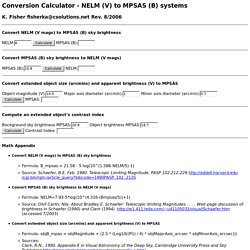
Fisher fisherka@csolutions.net Rev. 8/2006 Math Appendix Convert NELM (V mags) to MPSAS (B) sky brightness Formula: B_mpsas = 21.58 - 5 log(10^(1.586-NELM/5)-1) Source: Schaefer, B.E. Feb. 1990. Telescopic Limiting Magnitude. Light Pollution map. Close The light pollution map has two base layers (road and hybrid Bing maps), light pollution overlays and the user light pollution measurements overlay.
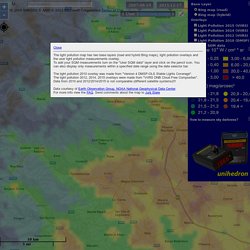
To add your SQM measurements turn on the "User SQM data" layer and click on the pencil icon. You can also display only measurements within a specified date range using the date selector bar. The light pollution 2010 overlay was made from "Version 4 DMSP-OLS Stable Lights Coverage". The light pollution 2012, 2014, 2015 overlays were made from "VIIRS DNB Cloud Free Composites". Data courtesy of Earth Observation Group, NOAA National Geophysical Data Center. Royal Museums Greenwich. Frontiers and Controversies in Astrophysics — Open Yale Courses. About the Course This course focuses on three particularly interesting areas of astronomy that are advancing very rapidly: Extra-Solar Planets, Black Holes, and Dark Energy. Particular attention is paid to current projects that promise to improve our understanding significantly over the next few years.
The course explores not just what is known, but what is currently not known, and how astronomers are going about trying to find out. View class sessions » Course Structure This Yale College course, taught on campus twice per week for 50 minutes, was recorded for Open Yale Courses in Spring 2007. Cieli Perduti - Home. HOME. Untitled. Want to stay on top of all the space news?
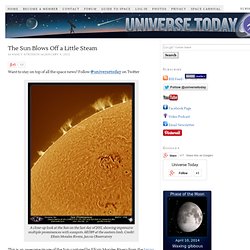
Follow @universetoday on Twitter A close-up look at the Sun on the last day of 2011, showing impressive multiple prominences with sunspots AR1389 at the eastern limb. Credit: Efrain Morales Rivera, Jaicoa Observatory This is an awesome image of the Sun captured by Efrain Morales Rivera from the Jaicoa Observatory in Aguadilla, Puerto Rico, on December 31, 2011. A Balanced Budget on Titan. Want to stay on top of all the space news?
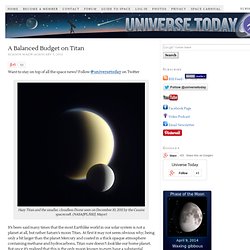
Follow @universetoday on Twitter Hazy Titan and the smaller, cloudless Dione seen on December 10, 2011 by the Cassini spacecraft. (NASA/JPL/SSI/J. How Can Growing Galaxies Stay Silent? Want to stay on top of all the space news?
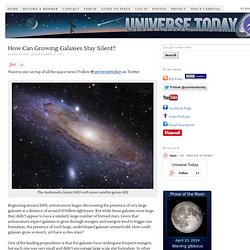
Follow @universetoday on Twitter The Andromeda Galaxy (M31) with minor satellite galaxy M32 Beginning around 2005, astronomers began discovering the presence of very large galaxies at a distance of around 10 billion lightyears. But while these galaxies were large, they didn’t appear to have a similarly large number of formed stars. Given that astronomers expect galaxies to grow through mergers and mergers tend to trigger star formation, the presence of such large, undeveloped galaxies seemed odd. One of the leading propositions is that the galaxies have undergone frequent mergers, but each one was very small and didn’t encourage large scale star formation. Dusty Plasma From Enceladus Might Affect Saturn’s Magnetosphere. Want to stay on top of all the space news?

Follow @universetoday on Twitter Cassini View Of Saturn - Credit: Credit: NASA/JPL-Caltech Discovered by the Cassini mission, Saturn Kilometric Radiation (SKR) has been something of an enigma to astronomers. According to the radio and plasma wave instruments, variations occur in sync with the planet’s rotation. However, there are periodic “bursts” of radiation which are in line with Saturn’s magnetosphere. The Workings of our Solar System Creates Beautiful Musical Palindrome.
Want to stay on top of all the space news?
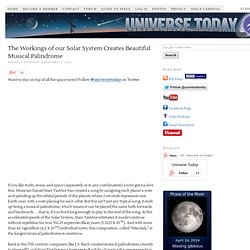
Follow @universetoday on Twitter If you like math, music and space (separately or in any combination) you’re gonna love this. Musician Daniel Starr-Tambor has created a song by assigning each planet a note and speeding up the orbital periods of the planets where 2 seconds represents one Earth year, with a note playing for each orbit. But this isn’t just any typical song; it ends up being a musical palindrome, which means it can be played the same both forwards and backwards … that is, if you lived long enough to play to the end of the song.
Saturn's Largest Moon Seen in Unprecedented Detail. Titan is one of the solar system’s coldest places, but that hasn’t stopped Saturn’s largest moon from being incredibly dynamic.A collection of 13 new studies about Titan show previously undetected craters and river deltas, and provide improved maps of its surface and interior.They also reveal new details about the moon’s mysterious 29.5-Earth-year-long seasonal cycle (the equivalent of one year on Saturn, which orbits the sun at a distance of 890 million miles).

“We’re really starting to see quite a lot of profound changes on Titan,” said planetary scientist Ralph Lorenz at Johns Hopkins University’s Applied Physics Laboratory. Backyard Science: How You Can Make a Difference. Want to stay on top of all the space news?
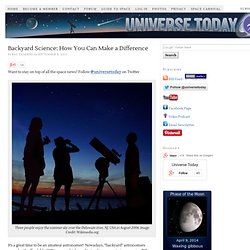
Follow @universetoday on Twitter Three people enjoy the summer sky over the Delaware river, NJ, USA in August 2006. Image Credit: Wikimedia.org It’s a great time to be an amateur astronomer! Nowadays, “backyard” astronomers armed with affordable CCD imagers, high-quality tracking mounts, inexpensive PC’s and the internet at their fingertips are making real contributions to Astronomy science. How are people in their backyards contributing to real science these days? Consider that in 1991, the Hubble Space Telescope launched with a main camera of less than 1 megapixel. With access to fairly high resolution cameras and equipment, many amateurs have taken breathtaking images of the night sky. One spectacular example of amateur discoveries was covered by Universe Today earlier this year.
Often times when a supernova is detected, scientists must act quickly to gather data before the supernova fades. A before and after animation of Supernova 2010lt. 2013 Meteor shower viewing times and information at Spacedex.com. Il 2013 anno delle comete, Ison sarà “più luminosa della luna piena” NASA e-Book Features. March to the Moon Image Gallery. 10 Years of Gorgeous Images of Earth From Space. 10 Years of Aqua Satellite's Incredible Images of Earth From Space. VISTA gigapixel mosaic of the central parts of the Milky Way. Your ‘Supermoon’ Images from Around the World. Want to stay on top of all the space news?

Follow @universetoday on Twitter San Souci lighthouse and the perigee Moon, in the Dominican Republic. Credit: Goku Abreu. The Best of Hubble: 22 Years of Amazing Images. Want to stay on top of all the space news? Follow @universetoday on Twitter 22 years ago today, the Hubble Space Telescope launched into orbit.
After overcoming initial problems, Hubble has gone on to become legendary, helping scientists to rewrite astronomy textbooks. To celebrate Hubble’s 22nd anniversary, here’s a slideshow from ESA’s Hubblecast that shows some of the best images from over two decades in orbit, set to specially commissioned music. GRAIL Sends Back First Video of the Moon’s Far Side. Want to stay on top of all the space news? Follow @universetoday on Twitter A first look from GRAIL, showing the lunar far side!
NASA’s New Video, Voiced by Optimus Prime. NASA's Fermi Telescope Finds Giant Structure in our Galaxy. Beautiful Time-Lapse Video Shows Stars and Earth From Space Station. A stunning new time-lapse video shows off the movements of both the stars and our home planet as seen from the International Space Station. While other videos have mostly focused on the nighttime Earth rolling by, photographer Alex Rivest wanted to highlight something new. He enhanced publicly available data from NASA’s Johnson Space Center to focus each shot on the background moving stars.
The result is enough to make any backyard stargazer incredibly jealous. “As someone who tries to get away from light pollution to look up and get lost under the stars (I always take star time-lapse movies whenever I get away from the city lights), I am fascinated by what the stars must look like from space,” Rivest wrote in an email to Wired Science.
“This particular track, to me, made it feel like one was taking a stroll in low earth orbit, watching the stars.” "The Most Amazing Highest Resolution Image of Earth Ever," Says NASA. New Mesmerizing Video Shows the Whole Evolution of the Moon. Stop What You're Doing and Explore Mars Right Now. 2012 March 12 - The Scale of the Universe Interactive. Discover the cosmos! Each day a different image or photograph of our fascinating universe is featured, along with a brief explanation written by a professional astronomer. 2012 March 12. This Beautiful Space Video Will Make You Have Flying Dreams Tonight. This Incredible Video Shows All Roads, Air, and Shipping Routes on the Entire Planet.
Mathematic Proof That The Universe Had A Beginning. Cassini Exposes Phoebe As More Planet Than Moon. The Mystery of Venus’ Ashen Light. Earth Has Less Water Than You Think. Moon Phases: 6000 Year Catalog. Cassini Solstice Mission. La pagina degli astrofili. Software, fenomeni celesti, effemeridi, eclissi, calendario lunare, la cometa dell'anno. Associazione Astrofili Vittorio Veneto. Immaginario Scientifico. Astro Anarchy.